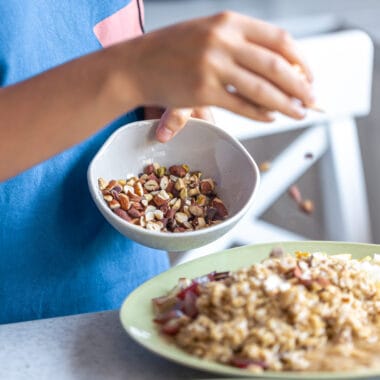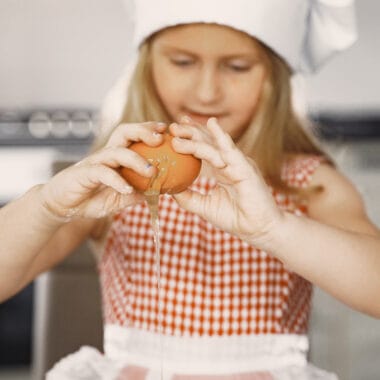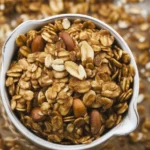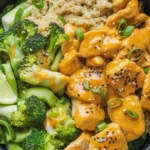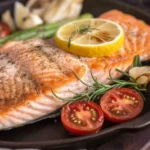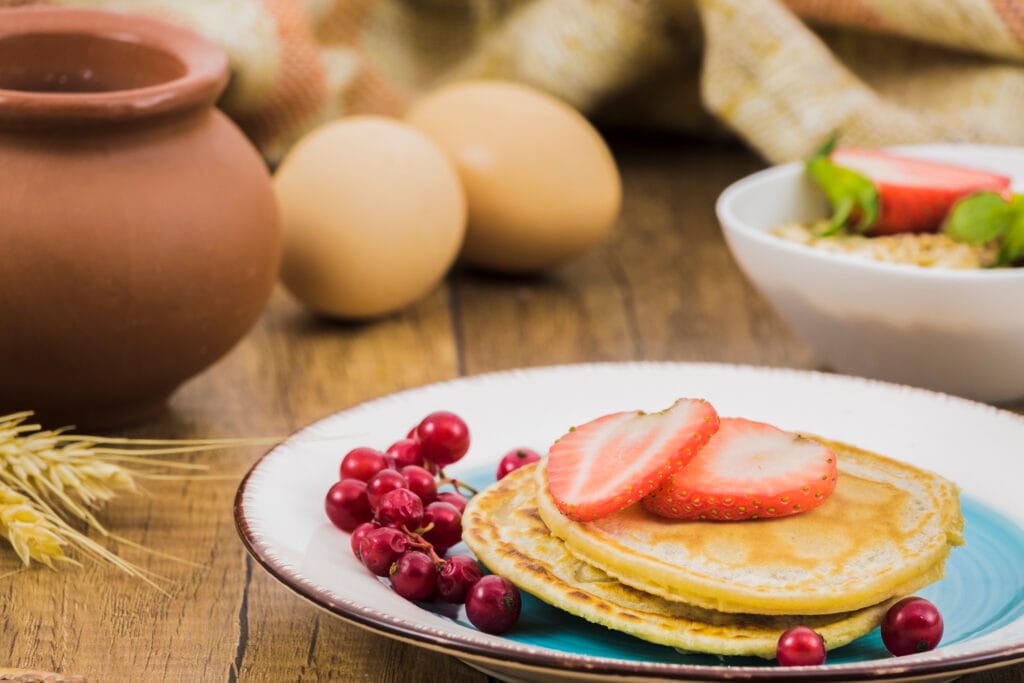
Imagine a weekend morning where your kids eagerly jump out of bed, excited about breakfast — not because of a sugary cereal or syrup-laden pancakes, but because you’ve crafted a batch of wholesome, low sugar pancakes that taste just as indulgent. As parents, we all want to serve our children nutritious foods that nourish their growing bodies and minds, but that doesn’t mean sacrificing flavor or fun. Enter low sugar pancake recipes — a wonderful way to strike that perfect balance.
In this comprehensive guide, we’ll explore everything you need to know about making irresistible low sugar pancakes for kids. From ingredient choices and health benefits to fun toppings and expert tips, this article is packed with insights, practical advice, and delicious recipes that will elevate your breakfast game.
Read Also: Why Make-Ahead Breakfast Bowls Are a Game-Changer
Why Opt for Low Sugar Pancakes for Kids?
Before diving into recipes, let’s understand why reducing sugar in breakfast options is essential. The typical American diet often includes more added sugars than recommended, especially in processed foods and breakfast items. The American Heart Association suggests children consume no more than 25 grams of added sugar daily, yet many kids surpass this amount easily.
Consuming excess sugar can lead to a host of health issues, including obesity, type 2 diabetes, dental cavities, and even behavioral problems like hyperactivity and difficulty concentrating. Starting the day with a low sugar breakfast helps stabilize blood sugar levels, sustain energy, and promote healthier eating habits over time.
Moreover, many store-bought pancake mixes and syrups are loaded with added sugars and artificial additives. Making pancakes from scratch allows you to control what goes in, ensuring your little ones get a nourishing start to their day.
The Basics of Making Low Sugar Pancakes
1. Choosing the Right Flour
Opt for whole grain flours such as whole wheat, oat, or buckwheat for added fiber and nutrients that support digestion and sustained energy. These flours also have a naturally nutty flavor that complements pancake batter beautifully.
2. Sweetening Naturally
Instead of refined sugar, natural sweeteners like mashed bananas, applesauce, dates, or a splash of honey (used sparingly for children over 1 year old) can add sweetness without the blood sugar spike. Additionally, incorporating vanilla extract or cinnamon can enhance perceived sweetness through natural flavor nuances.
3. Enhancing Moisture and Texture
Adding Greek yogurt, buttermilk, or milk alternatives (like almond or coconut milk) keeps pancakes tender and moist while boosting protein and calcium content.
4. Using Healthy Fats
A small amount of olive oil, coconut oil, or nut butters can improve texture and flavor, as well as provide healthy fats essential for brain development.
Popular Low Sugar Pancake Recipes for Kids
Let’s explore some tried-and-true recipes that balance flavor and healthfulness, making breakfast both fun and nourishing.
Classic Whole Wheat Banana Pancakes
Ingredients:
- 1 cup whole wheat flour
- 1 ripe banana, mashed
- 1 teaspoon baking powder
- 1/2 teaspoon cinnamon
- 1 cup milk (dairy or plant-based)
- 1 large egg
- 1 teaspoon vanilla extract
- 1 tablespoon honey (optional, for slightly more sweetness)
Preparation:
- In a bowl, whisk together the dry ingredients.
- In another bowl, mash the banana and whisk in the milk, egg, vanilla, and honey.
- Combine wet and dry ingredients until just mixed.
- Heat a non-stick skillet over medium heat. Pour batter in small rounds.
- Cook until bubbles form on the surface, then flip and cook until golden.
- Serve with fresh fruit and a drizzle of pure maple syrup (used sparingly).
Why it works: The banana provides natural sweetness and moisture, reducing the need for added sugar. Whole wheat flour boosts fiber, promoting better digestion.
Oatmeal Pancakes with Applesauce
Ingredients:
- 1 cup rolled oats (ground into flour)
- 1/2 cup whole wheat flour
- 1 teaspoon baking powder
- 1/2 teaspoon baking soda
- 1/2 teaspoon salt
- 1/2 teaspoon cinnamon
- 1 cup unsweetened applesauce
- 3/4 cup milk
- 2 eggs
- 1 teaspoon vanilla extract
Preparation:
- Mix dry ingredients in a large bowl.
- In a separate bowl, whisk together applesauce, milk, eggs, and vanilla.
- Combine wet and dry, stirring until just blended.
- Cook on a greased skillet over medium heat until bubbles form, then flip.
- Serve topped with fresh fruit or a dollop of Greek yogurt.
Benefits: Applesauce replaces sugar and adds moisture, fiber, and antioxidants, making these pancakes a wholesome choice.
Protein-Packed Cottage Cheese Pancakes
Ingredients:
- 1/2 cup cottage cheese
- 2 eggs
- 1/2 cup oats
- 1 teaspoon vanilla
- 1/4 teaspoon baking powder
- Optional: a handful of blueberries or chocolate chips (preferably dark or sugar-free)
Preparation:
- Blend all ingredients until smooth.
- Pour batter onto a hot skillet and cook until golden.
- Serve with fresh berries and a sprinkle of nuts.
Why it’s great: The cottage cheese adds protein, helping keep kids full longer and supporting growth and development.
Creative Toppings and Add-ins to Make Breakfast Exciting
While these recipes are naturally flavorful, the right toppings can turn simple pancakes into a feast. Here are some ideas:
- Fresh berries (strawberries, blueberries, raspberries)
- Sliced bananas or kiwi
- A drizzle of pure maple syrup or honey (used sparingly)
- Greek yogurt or coconut cream
- Chopped nuts or seeds
- Unsweetened nut butters (almond, peanut, cashew)
- Shredded coconut
- Dark chocolate chips (in moderation)
Making pancake time interactive by letting kids choose their toppings not only encourages healthy eating but also makes breakfast more fun.
Tips for Perfect Low Sugar Pancakes Every Time
- Don’t overmix: Mix just until ingredients are combined to keep pancakes fluffy.
- Preheat your pan: A properly heated skillet ensures even cooking and prevents sticking.
- Use non-stick or lightly greased pans: Reduces the need for excess fats.
- Adjust sweetness: Taste the batter before cooking; some natural ingredients like ripe bananas may provide enough sweetness.
- Make ahead and freeze: Leftover pancakes can be frozen and reheated, making busy mornings easier.
Nutritional Comparison Table: Traditional vs. Low Sugar Pancakes
| Feature | Traditional Pancakes | Low Sugar Pancakes |
|---|---|---|
| Main Flour | White wheat flour | Whole wheat, oats, or alternative flours |
| Added Sugar | Usually 2–4 tbsp per serving | Minimal or natural sweeteners (banana, applesauce) |
| Sweeteners | Maple syrup, honey, sugar | Fruit purees, vanilla, cinnamon |
| Fiber Content | Low | High (due to whole grains, fruits) |
| Protein | Moderate | Often higher (with added eggs, yogurt, cottage cheese) |
| Nutrients | Lower in micronutrients | Rich in fiber, vitamins, minerals |
| Blood Sugar Impact | Higher | Lower and more stable |
This comparison highlights how low sugar recipes can be both delicious and nutritionally superior, supporting your child’s health in the long term.
Expert Insights and Resources
Nutritionists emphasize the importance of gradual flavor adaptation. Introducing less sweet foods early helps children develop a preference for natural flavors and reduces cravings for sugary foods later. The American Academy of Pediatrics recommends limiting added sugars to promote healthier habits, and many pediatric health websites like Kids Eat in Color provide fantastic tips for balanced breakfasts.
Incorporating a variety of nutrient-dense foods, including low sugar pancakes, supports overall growth, cognitive development, and immune health. For further guidance, consulting registered dietitians or pediatric nutritionists can help craft personalized meal plans suited to your child’s needs.
Frequently Asked Questions (FAQs)
Q1: Can I add a little sugar if my kids prefer sweeter pancakes?
A: Yes, but keep it minimal. Using natural sweeteners like mashed bananas or applesauce provides sweetness without excess sugar. Over time, children can learn to enjoy less sugary foods.
Q2: Are low sugar pancakes suitable for all ages?
A: Absolutely. Adjust ingredients as needed. For infants under one year, avoid honey and certain allergens, and always consult with a pediatrician.
Q3: How do I store and reheat leftover pancakes?
A: Store in an airtight container in the fridge for up to 3 days. Reheat in a toaster or microwave until warm.
Q4: Can I make these pancakes vegan?
A: Yes. Use plant-based milk, flaxseed or chia seed “eggs,” and avoid honey. Many recipes adapt easily with substitutes.
Q5: How can I make pancakes more appealing to picky eaters?
A: Incorporate their favorite fruits, let them choose toppings, or shape pancakes into fun forms like animals or stars.
Conclusion: Embracing Wholesome Breakfasts
Starting your day with low sugar pancakes for kids isn’t just about reducing sugar — it’s about creating a nourishing, enjoyable, and sustainable breakfast routine that fosters healthy habits. By choosing wholesome ingredients, experimenting with flavors, and involving your children in the process, you turn breakfast into a joyful family tradition.
Remember, small changes make a big difference. Gradually reducing sugar and emphasizing whole foods can shape your child’s palate and health for years to come. With these recipes and tips, you’re well on your way to serving delicious, low sugar pancakes that your kids will love and that support their growth and well-being.
Here’s to happy mornings, happy kids, and healthier lives — one pancake at a time.
